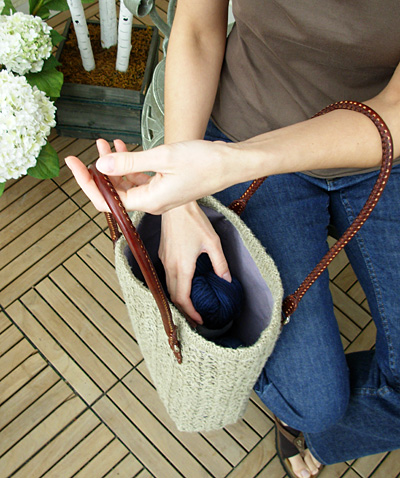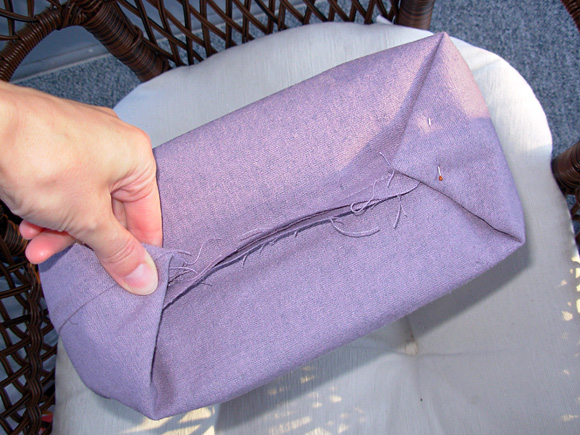|













![Read exactly what FREE PATTERNS really means...respect our designers and authors rights [and thank you]](../images/OFFnavLEGAL.gif)



 
|
 |
 <click
for more! <click
for more!
 
|
| 
  by
Lee Juvan by
Lee Juvan

I admire women who
carry small purses, but I am not one of them.
When I leave the house, even if it’s only to drop the kids off
at school, I carry a satchel of sufficient
size to see a more streamlined traveler through
several time zones. (It’s my Eastern
European heritage: every time we leave a place,
we prepare to be away for several generations.)
I console myself by trying to carry a bag that
is stylish and interesting—and by reminding
myself that women with small purses certainly
do not have at hand the makings for several
pairs of socks, a sweater sleeve, two scarves,
a drop spindle, and yak down.
Brighton is knitted
in a simple Shetland lace pattern, in the
round from the top down, and ends with a
gracefully shaped bottom gusset and a three-needle
bind off. This bag will serve as a constant
reminder of your spinning prowess. Imagine
standing in line at the farmer’s
market and saying, “Why yes, I did spin
the flax for my bag, but it didn’t require
a distaff. How astute of you to notice.” (Okay,
maybe this is more likely to happen at SOAR.)
Brighton will carry a whole summer’s
day worth of supplies for whatever life throws
at you, be it foreign invasion or impromptu
knitting in the park.
|
|
 model: Lee
Juvan
model: Lee
Juvan  photos: Lee and Tom Juvan
photos: Lee and Tom Juvan |
|
| |
| One |
Height: 13
inches
Width: 13.5 inches
Depth: 4 inches |
 Handspun
sport-weight 3-ply linen yarn from Euroflax
long line flax -
1 strick/7 oz,
wpi 14-15; approx. 264yd/241m (5.3 ounces/150
grams) Handspun
sport-weight 3-ply linen yarn from Euroflax
long line flax -
1 strick/7 oz,
wpi 14-15; approx. 264yd/241m (5.3 ounces/150
grams)
See Pattern Notes re. yarn substitution.
Recommended needle size:
 1
US #5/3.75mm 24-inch circular needle 1
US #5/3.75mm 24-inch circular needle
 1
US #6/4.0mm 24-inch circular needle 1
US #6/4.0mm 24-inch circular needle
 1
set US #6/4.0 mm double-point needles 1
set US #6/4.0 mm double-point needles
[always use a needle size that gives you the gauge listed below
-- every knitter's gauge is unique]
 Stitch
Markers Stitch
Markers
 Tapestry Needle Tapestry Needle
 Approx.
1.5 yards lining fabric (Note:
See Pattern Notes before buying fabric) Approx.
1.5 yards lining fabric (Note:
See Pattern Notes before buying fabric)
 1.5 yards mid-weight fusible interfacing 1.5 yards mid-weight fusible interfacing
 1 piece Timtex stabilizer or plastic canvas for bottom, approx. 12 x 4
inches 1 piece Timtex stabilizer or plastic canvas for bottom, approx. 12 x 4
inches
 Bag handles (I used Grayson
E leather handles, large rolled 25 inches,
sold in a set of two) Bag handles (I used Grayson
E leather handles, large rolled 25 inches,
sold in a set of two)
 Sewing thread in colors to match both lining and bag Sewing thread in colors to match both lining and bag
 Heavy-duty quilting or buttonhole thread – used to attach handle Heavy-duty quilting or buttonhole thread – used to attach handle
 Sewing machine Sewing machine
 Straight pins Straight pins
|
|
17 sts/24 rows
= 4 inches in stockinette st using US #6/4.0mm
needles, lightly blocked
Note: Correct gauge is not critical for this project, but your final measurements
and yardage requirements may vary if your gauge is different. |
| [Knitty's
list of standard abbreviations and techniques
can be found here] |
You can easily
substitute a commercial sport or DK weight
linen, hemp, or cotton yarn. Good substitutes
include Euroflax Sport Weight, Hemp for Knitting
Allhemp6, Berroco’s NaturLin, or Knit
Picks CotLin. Remember that yardage requirements
(and gauge) may vary with another yarn.
The size of the finished bag will also vary
according to how severely you choose to block
the lace. I preferred a lightly blocked, rustic
look. It’s best to finish the knitting
and blocking before buying the lining fabric.
While it’s possible to sew the lining
by hand, doing so by machine will greatly increase
the strength of the bag.
Bead Stitch (Worked in the round over a multiple
of 7 sts):
Round 1: [K1, k2tog, yo, k1, yo, ssk, k1] to
end.
Round 2: [K2tog, yo, k3, yo, ssk] to end.
Round 3: [K1, yo, ssk, k1, k2tog, yo, k1] to
end.
Round 4: [K2, yo, k3tog, yo, k2] to end.
Repeat these 4 rounds for Bead Stitch.
Adapted for knitting in the round from Barbara
Walker’s first A Treasury of Knitting
Patterns
Three-Needle Bind Off
Hold both pieces of knitting with wrong sides
together.
Insert needle into first st on front needle
and first st on back needle, and knit them
together. *Repeat this for the next st on the
front and back needles. Draw the first st worked
over the second st.*
Repeat from * to * until all sts have been
bound off. Break yarn and draw through remaining
st. |
|
  Using
smaller circular needle, CO 112 sts. Place
marker and join to work in the round, being
careful not to twist. Using
smaller circular needle, CO 112 sts. Place
marker and join to work in the round, being
careful not to twist.
K 7 rounds.
P 1 round. This round forms a turning ridge for the facing.
Using larger circular needle, k 5 rounds.
Work in Bead Stitch until work measures 13
inches from turning ridge or desired length,
ending with Round 4 of pattern.
Next Round: K14, place marker, k42, place
marker, k14, place marker, k42.
P 1 round.
Shape Bag Bottom:
K 1 round.
Decrease Round: [Ssk, k to 2 sts before marker,
k2tog] 4 times.
Repeat these 2 rows 5 times more. 64 sts;
2 sts remain between each pair of markers.
Next Round: K2tog, remove marker, k to next
marker, remove marker, k2tog, remove marker,
k30. 62 sts.
Slip first 32 sts to smaller needle; 30 sts
remain on larger needle. With RS facing, join
bottom of bag using Three-Needle Bind Off,
working 2 sts together at beginning and end
of smaller needle. BO will form a ridge on
RS of work. |
|
|   Weave in all ends. Weave in all ends.
Hand wash in cool water and
lay flat to dry. When the fabric is nearly
dry, iron bag from the WS, gently stretching
lace pattern to desired openness. The more
pressure you apply, the flatter and shinier
your fabric will be.
If you prefer a more textured,
rustic fabric, press lightly.
Lining:
Once the bag is blocked and dry, lay it flat
and measure its height and width. Double
the width of the bag to find its circumference.
Cut a piece of lining fabric with the following
measurements:
Width:
Bag circumference + 1 inch
Height:
[2 x Bag height] + 3 inches
Cut a piece of fusible interfacing
that is 1 inch smaller than the lining in both
height and width. Apply interfacing to WS of
lining, centering it so that the 0.5-inch seam
allowances are not interfaced.
  Fold lining in half widthwise with WSs together
as shown in diagram. Press the fold; this fold
will become the upper edge of the lining once
it is inserted. Fold lining in half widthwise with WSs together
as shown in diagram. Press the fold; this fold
will become the upper edge of the lining once
it is inserted.
Unfold lining. If you wish to sew pockets
and add them to the inside of the lining, do
so now. Fold in half lengthwise with RSs together
and sew along side edge of lining, forming
a tube with the same circumference as the bag.
Press seam open.
Fold half of the tube outwards along the pressed
fold line, so that WS of fabric is completely
hidden. Sew a seam close to fold line.
Lay lining flat and
sew across lower (cut) edges, through all
4 thicknesses. Press seam open. Form gusset
by opening bag lining flat, with bottom seam
at center of bag bottom. Sew straight across “triangles” at
corners, approx. 2.5 inches in from ends. Secure
triangles on outside of bottom with a few stitches.

Base:
Cut Timtex or plastic canvas to measurements
of bottom gusset, and cut two pieces of lining
fabric that are 1 inch longer and wider than
the plastic canvas pieces. With RSs together,
sew pieces of fabric together along three
edges, forming a pocket for the canvas. Turn
pocket right side out and press seams. Insert
plastic canvas and sew pocket closed by hand.
Place lining inside knitted
bag and pin into place. Fold knitted facing
to inside along turning ridge and stitch to
lining through all layers by hand (use thread
to match the knitted bag, not the lining).
Sew through all layers around bottom of bag
along purl round at beginning of gusset and
across ridge of BO. This will ensure that
the lining and knitted bag hold their shape.
Insert base into bag and tack down by hand.
Sew handles to bag through all thicknesses
using heavy-duty thread. |
|   Lee
Juvan lives with her family in Vermont, where
she carries a large handbag and maintains a
small shop at workwoman.etsy.com. Lee
Juvan lives with her family in Vermont, where
she carries a large handbag and maintains a
small shop at workwoman.etsy.com.
She is the
designer of Sugar
on Snow, Unmentionables,
and Emma’s Unmentionables. Her work has
also appeared in Spin-Off. More of her
designs will soon be available on Ravelry.
|
| Pattern
& images © 2008 Lee Juvan.
Contact Lee |
|
|
|
|
|

